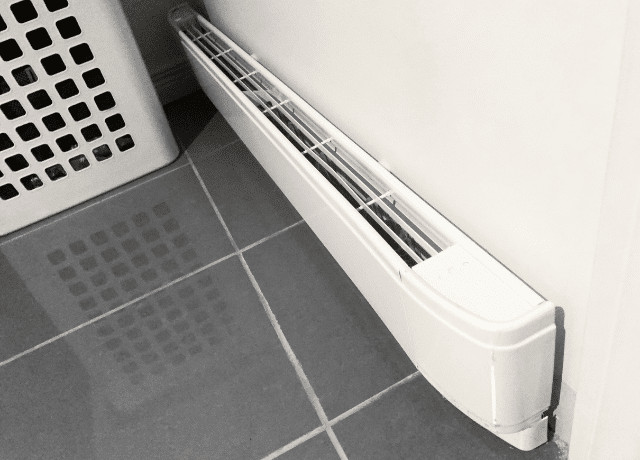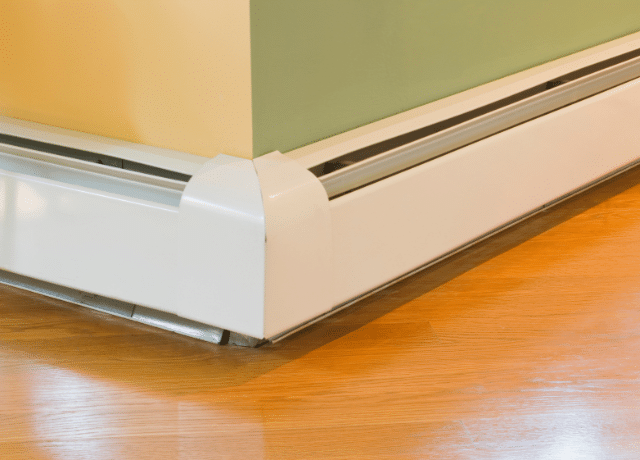Introduction – Baseboard Heating
Baseboard heaters are one of the most popular options for preventing pipes from freezing in cold weather. These devices can be installed on a pipe and turned on when needed to warm up the room around it evenly. A 220-volt baseboard heater produces a great deal of heat, making it ideal for large rooms or poorly insulated rooms.

Be Warned: Electricity-Based Heating Is Not Efficient
However, be warned here that electricity-based radiative heating like baseboards are one of the most inefficient types of heating. They are beaten by natural gas furnaces and heat pumps and almost any way of getting heat. It will cost you 30-40% more to use electrical heating. This may not be a problem if you live in a small apartment where the heating needs are about half.
In a large house, you’re better off doing a fundamental re-evaluation of heating options. One way to mitigate this inefficiency is to use solar panels to ensure that you have excess electricity production which will bring down operating costs to zero. The drawback with solar panels is the upfront investment. The solar panel company will be able to show what your time to return-on-investment is.
There Are Three Types of Baseboard Heaters
Different baseboard heaters are available, such as electric baseboard heaters, hydronic baseboard heaters, or oil-filled radiators. Each type has its pros and cons, depending on your needs. They can also be coupled to natural gas furnaces which avoids the electricity efficiency problem we warn you about.
Hydronic versions means a central electric furnace heats up water that circulates the house. Plain electric baseboards and oil-filled radiators tend to be standalones that plug into outlets and are installed separately in each room.
Baseboard heaters produce hot air and circulate it through the room via convection currents. They can be installed with an electrical outlet nearby, making them easy to set up and remove when not needed. Because electric baseboard heaters are installed directly on the wall and not in a cabinet, they tend to be more efficient than other options.
Three Brand Suggestions For Standalone 220V Electric Baseboard Heaters
You are most likely looking for a 220V (sometimes 240V) plug-in, standalone baseboard heater. In this case, here are three manufacturers that are known for their high-quality electric baseboard.
1. Cadet

Cadet offers a wide range of electric baseboard heaters, with models available for both 120V and 240V. They’re well-regarded for their quality, durability, and efficiency. To be more specific, the model pictured above operates at 208V which will work fine if you have a 220V/240V outlet.
2. Fahrenheat

Fahrenheat’s baseboard heaters are also a good option, offering both hydronic and traditional electric models. They’re known for their reliability and robust construction. The one pictured above is noted for installation in these areas:
Bedrooms; Living/Family Rooms; Kitchens; Bathrooms; Basements; Offices; Conference Rooms; Hallways; Lobbies; Waiting Rooms
2500 series page
3. Dimplex

Dimplex is another trusted brand, known for its innovative heating solutions. They offer a variety of electric baseboard heaters, and are particularly noted for their energy-efficient designs. The one pictured above draws 375-500 watts and is rated for 240V (actually 208V).
220-Volt Baseboard Heater – Requires Dedicated 220 Circuit
A 220V heater carries a higher voltage than a 110V heater, and incorrect wiring or a malfunctioning appliance can cause electric shock or fire. It also requires a dedicated 220V circuit, which may not be available in some homes.
On the other hand, a 220-volt baseboard heater is a reasonable option for providing efficient and long-lasting heat in your home or office. Unlike traditional heating systems, baseboard heaters are installed along the base of walls, leaving your floors and furniture free from bulky vents or radiators. And because they run on 220 volts, these heaters have a higher power output at lower current, allowing them to work even in larger spaces.
In addition, 220-volt baseboard heaters have a longer lifespan than their 110-volt counterparts, with some models lasting over 20 years with proper maintenance and care. So if you’re looking for a reliable heating solution that won’t take up too much space, consider investing in a 220-volt baseboard heater. It’s sure to keep you warm for years to come. Best of all? They provide consistent and affordable heat without worrying about potential fire hazards often associated with space heaters or fireplaces.
Why (Not To) Choose A 220-Volt Baseboard Heater?
Why should you choose this option over a traditional furnace or space heater? A 220-volt baseboard heater offers ultra-quiet operation and precise temperature control. You can also install it in areas where other heating options may not fit due to its slim design.
But we should be objective – one big drawback is that terms of energy efficiency, a 220-volt baseboard heater is really easy to beat – it uses more energy than other heating methods and can cost more. However, with its low maintenance and long lifespan, a 220-volt baseboard heater ultimately may prove less troublesome.
220V Is Not Much Cheaper To Run Than 110V
This topic is a subject of debate among homeowners and appliance users. In general, 220V devices require a tiny bit less energy to operate than 110V devices because of a small gain in efficiency. However, the reality is that the power or energy used over time factors in both voltage and current. A 220V device runs at twice the voltage with half the current. A 110V device runs at half the voltage and twice the current. Power is given by P = I·V, or the product of current (I) and voltage (V). So in the end, you’re using about the same energy.
Considering these factors is important before automatically assuming that 220V will save you money in the long run. Additionally, not all homes have access to 220V power outlets, so you may need to hire an electrician to install them before using appliances that require 220v electricity. Ultimately, the best way to determine which voltage will save you money is by consulting with a professional and researching the energy efficiency of specific appliances.

4 Things To Consider Before Buying Electric Baseboard Heaters
Electric baseboard heaters are an excellent option if you’re looking to heat smaller areas of your home, like bedrooms or bathrooms. Here are a few things to remember before purchasing an electric baseboard heater for your home or office.
Heat Output
Correctly sizing your electric baseboard heater is essential, as too little heat can be ineffective, while too much heat can be costly and potentially dangerous. Be sure to measure the square footage of the space you want to heat and consult with a professional about how powerful a heater you will need for those dimensions.
Installation
When installing an electric baseboard heater, it’s important to work with a qualified professional who has experience working with these types of heaters. This will ensure that the installation is done correctly and safely and that you get the most out of your new heater for years to come.
Space
Consider the size of the space where you plan to install the heater. Make sure it can heat that area effectively without using too much energy. Additionally, think about how often you will use the heater and whether or not you need any special features, such as programmable temperature controls or remote access via an app.
Cost
Of course, the final consideration when choosing an electric baseboard heater is cost. Do your research and compare prices from different retailers to find a high-quality model at an affordable price. With the right research, you can find an electric baseboard heater that meets all your heating needs without breaking the bank.
220-Volt Heaters Are Not Much More Efficient
We kind of answered this above regarding the cost. 220V will be slightly more efficient. The answer to this question depends on a few factors. First, it’s important to understand the difference between voltage and wattage. Voltage refers to the electrical pressure being delivered, while wattage refers to the amount of power being used. So, a 220-volt heater is not necessarily more efficient regarding wattage usage.
However, it may be more efficient in terms of heating ability. Higher voltages can heat up more quickly and effectively, leading to less wasted energy and potentially lower heating bills. Additionally, 220-volt heaters often have a higher maximum wattage capacity, meaning they’re capable of heating larger spaces more efficiently than lower-voltage heaters.
Interested in greater efficiency? Examine alternatives in this systematic comparison of heating systems.
Wrapping Up
If you are looking for a reliable, energy-efficient electric baseboard heater for your home or office, consider these key factors before purchasing. With the right research and professional help, you can find a model that fits your needs perfectly and keeps you warm all winter long!
